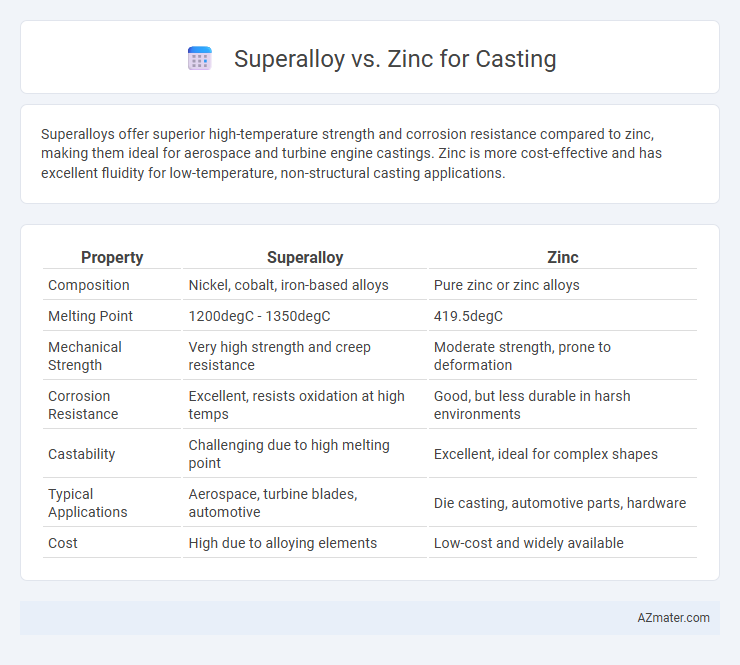Superalloys offer superior high-temperature strength and corrosion resistance compared to zinc, making them ideal for aerospace and turbine engine castings. Zinc is more cost-effective and has excellent fluidity for low-temperature, non-structural casting applications.
Table of Comparison
| Property | Superalloy | Zinc |
|---|---|---|
| Composition | Nickel, cobalt, iron-based alloys | Pure zinc or zinc alloys |
| Melting Point | 1200degC - 1350degC | 419.5degC |
| Mechanical Strength | Very high strength and creep resistance | Moderate strength, prone to deformation |
| Corrosion Resistance | Excellent, resists oxidation at high temps | Good, but less durable in harsh environments |
| Castability | Challenging due to high melting point | Excellent, ideal for complex shapes |
| Typical Applications | Aerospace, turbine blades, automotive | Die casting, automotive parts, hardware |
| Cost | High due to alloying elements | Low-cost and widely available |
Introduction to Casting Materials
Superalloys and zinc represent distinct categories of casting materials, each with specific properties suited for diverse industrial applications. Superalloys, composed primarily of nickel, cobalt, or iron-based alloys, offer exceptional strength, corrosion resistance, and high-temperature stability, making them ideal for aerospace and turbine components. Zinc, on the other hand, is favored for its low melting point, excellent fluidity, and cost-effectiveness, commonly used in die casting for automotive and consumer electronics parts.
Overview of Superalloys
Superalloys are high-performance materials primarily composed of nickel, cobalt, or iron, designed to withstand extreme temperatures, corrosion, and mechanical stress, making them ideal for casting components in aerospace, power generation, and automotive industries. These alloys exhibit exceptional strength and oxidation resistance due to their complex microstructure reinforced by elements such as chromium, aluminum, and titanium. Unlike zinc, which is softer and has lower melting points, superalloys enable the production of durable, heat-resistant castings critical for high-stress, high-temperature applications.
Properties of Zinc for Casting
Zinc offers excellent fluidity and low melting point, making it ideal for intricate casting designs and rapid production cycles. Its high dimensional stability and good wear resistance contribute to durable and precise cast components. Zinc also provides strong corrosion resistance and excellent mechanical properties, ensuring longevity in various industrial applications.
Mechanical Strength: Superalloy vs Zinc
Superalloys exhibit superior mechanical strength compared to zinc, making them ideal for high-stress applications such as aerospace and power generation components. Zinc alloys typically possess lower tensile strength and hardness, which limits their use to less demanding casting roles like decorative or low-load parts. The high-temperature resistance and durability of superalloys significantly outperform zinc, ensuring long-term structural integrity under extreme conditions.
Corrosion Resistance Comparison
Superalloys exhibit superior corrosion resistance compared to zinc when used in casting applications, due to their high chromium and nickel content that forms a stable oxide layer protecting against oxidation and chemical attack. Zinc, while cost-effective and easy to cast, is more prone to corrosion in humid or acidic environments, which limits its durability in harsh conditions. Cast superalloys maintain structural integrity and resist pitting and crevice corrosion significantly better than zinc alloys, making them ideal for high-performance and long-term applications.
Temperature Performance in Casting
Superalloys exhibit superior temperature performance in casting applications, maintaining structural integrity and mechanical strength at extreme temperatures often exceeding 1000degC, whereas zinc alloys typically melt around 419.5degC, limiting their use to lower-temperature environments. The high melting point and excellent thermal stability of superalloys enable them to withstand thermal cycling and oxidation better than zinc, making them ideal for aerospace and power generation components. Zinc's lower temperature tolerance results in faster wear and deformation under heat stress, restricting its casting use to decorative or low-load parts.
Cost Analysis: Superalloy and Zinc
Superalloys generally present a higher cost in casting due to expensive raw materials like nickel, cobalt, and chromium, coupled with complex production processes that ensure superior mechanical properties and corrosion resistance. Zinc alloys offer a cost-effective alternative with lower raw material prices and faster casting cycles, making them suitable for high-volume, low-stress applications. The choice between superalloy and zinc casting hinges on balancing upfront material and processing expenses against performance requirements and lifecycle costs in industrial use.
Applications in Industry
Superalloys excel in high-temperature and corrosion-resistant applications, making them ideal for aerospace turbine components, power generation, and chemical processing industries. Zinc alloys offer excellent fluidity and low melting points, preferred for automotive parts, electrical housings, and die-casting of consumer goods. Industry selection hinges on performance requirements, with superalloys suited for extreme environments and zinc alloys for cost-effective, precision casting.
Casting Processes Compatibility
Superalloys exhibit high compatibility with investment casting and vacuum casting processes due to their excellent high-temperature strength and oxidation resistance, allowing precise control over complex geometries and fine surface finishes. Zinc, with a lower melting point, is ideally suited for die casting processes, which enable rapid production and high dimensional accuracy but are less effective for intricate designs requiring heat resistance. The distinct thermal and mechanical properties of superalloys and zinc significantly influence their respective casting methods, optimizing the final component's performance and application.
Choosing the Right Material for Your Project
Selecting the right material for casting depends on performance requirements and environmental conditions. Superalloys offer exceptional heat resistance, mechanical strength, and corrosion durability, ideal for aerospace, automotive, and high-temperature applications. Zinc excels in cost-effectiveness, ease of casting, and dimensional accuracy, making it suitable for intricate, low-stress components and mass production.

Infographic: Superalloy vs Zinc for Casting
 azmater.com
azmater.com